Intel's Core 2 Extreme & Core 2 Duo: The Empire Strikes Back
by Anand Lal Shimpi on July 14, 2006 12:00 AM EST- Posted in
- CPUs
Application Performance using SYSMark 2004 SE
We'll kick off our look at general application performance with SYSMark 2004 SE and as always, and we'll look at the overall score as well as the scores in each of the two suites - Internet Content Creation and Office productivity.
As we saw in our last preview of Intel's Core 2 Extreme processor, it posted SYSMark scores that were well beyond anything either AMD or Intel had been able to deliver in the past. With the final version of Core 2 silicon in our hands and a more stable/tweaked platform, we got even better numbers out of Conroe:
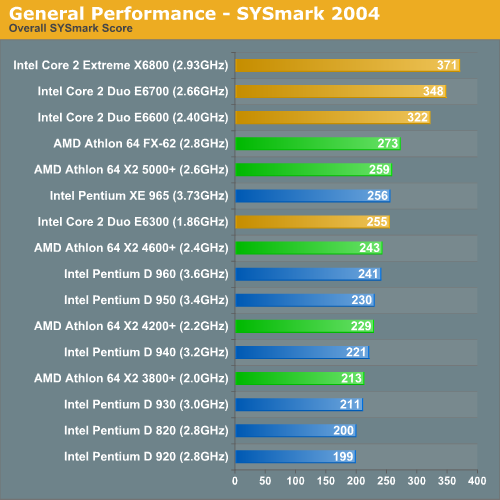
At the high end, the Core 2 Extreme X6800 was just under 36% faster than the Athlon 64 FX-62. In fact, even the $316 E6600 was around 18% faster than AMD's fastest. To add even more insult to injury the slowest Core 2 Duo in the test, the 1.86GHz E6300 is barely slower than AMD's fastest Athlon 64 X2.
The old Intel lineup of Pentium D processors is truly an embarrassment. Only the Extreme Edition 965 is remotely competitive and even then it can barely outperform the $183 E6300.
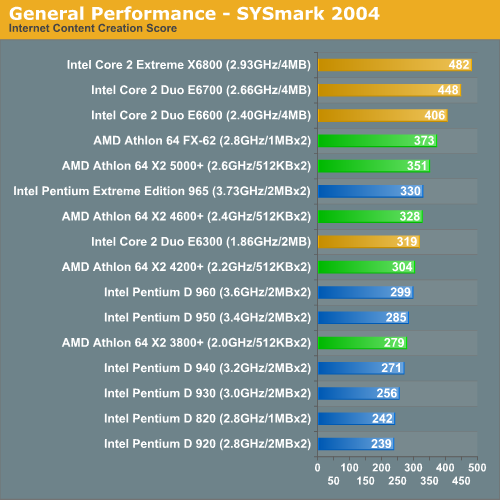
Drilling down into the SYSMark scores we've got the overall ICC results, which honestly are not much different than the overall scores we saw above. The Core 2 Extreme X6800 holds a 29% performance advantage over the FX-62 and once again, and the E6600 is able to outperform AMD's best by over 8%.
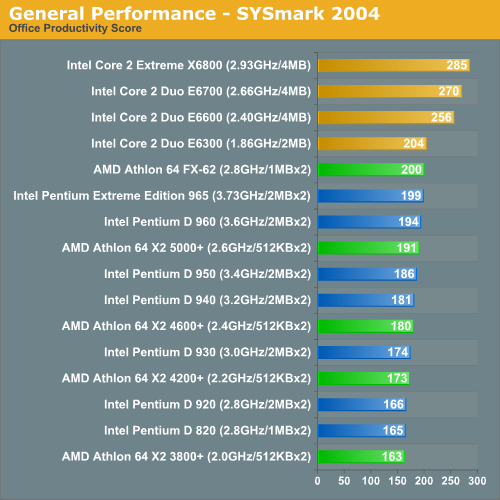
Intel's Core 2 performance domination continues in the Office Productivity portion of SYSMark 2004, with the Core 2 Extreme X6800 maintaining a 42.5% performance advantage over the FX-62. This time around, even the E6300 manages to remain competitive with the FX-62. This is Intel's new $183 part offering performance equal to that of AMD's $1,000 flagship FX processor; it's going to take a lot for AMD to recover from this deficit.
The individual SYSMark 2004 SE scores are graphed below if you're interested. The data is used in calculating the overall scores we've already discussed above:
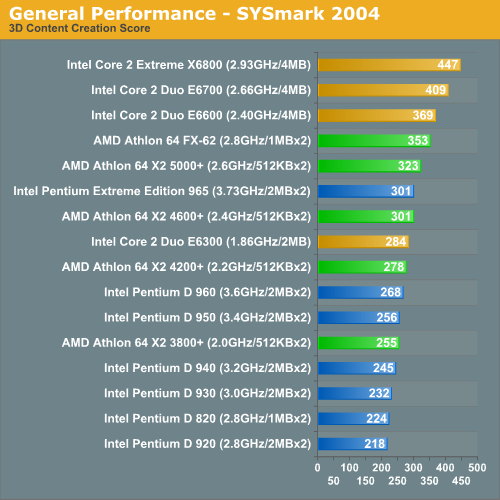
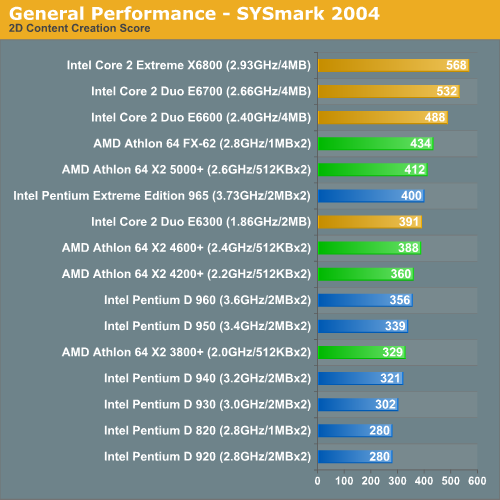
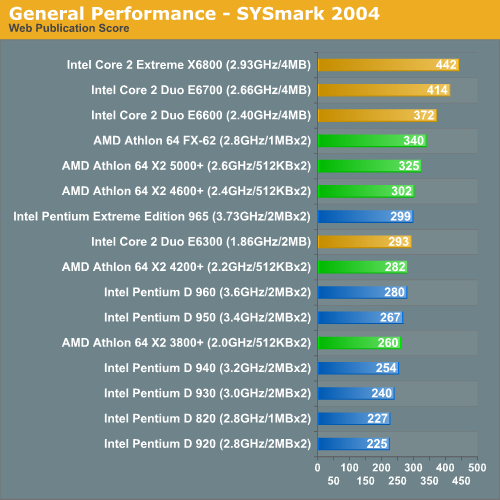
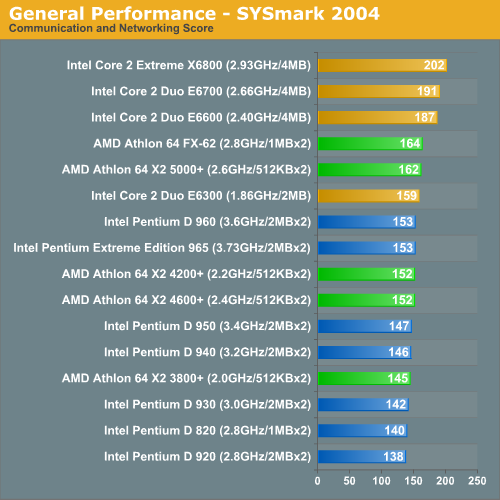
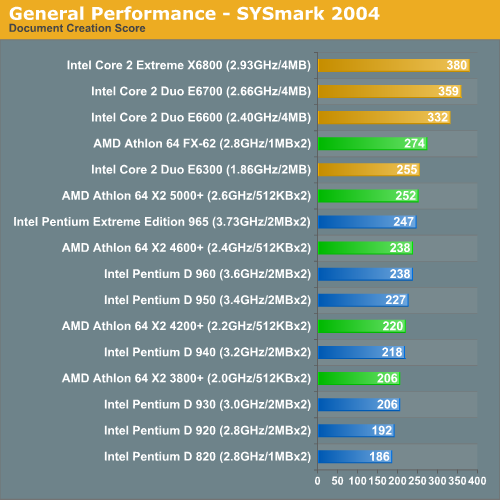
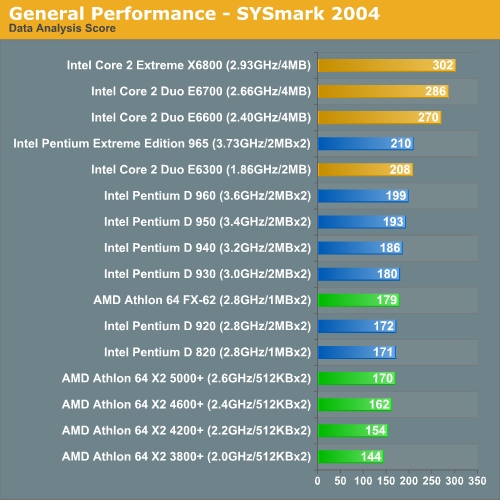










202 Comments
View All Comments
bob661 - Friday, July 14, 2006 - link
I agree. 20% is huge and noticeable.Chadder007 - Friday, July 14, 2006 - link
AMD's midrange holds up pretty well but when you go higher the Core2 crushes AMD this time.I would really like to see some X64bit benchmarks though to see how they will both fair with the future OSs.
Gary Key - Friday, July 14, 2006 - link
Coming shortly along with MCE2005......bob661 - Friday, July 14, 2006 - link
Don't confuse the Core Solo with the Core 2 Duo. The Solo is still Netburst whereas the Core 2 Duo is a new architecture.DrMrLordX - Friday, July 14, 2006 - link
Um what? Core Solo isn't Netburst. It's a single-core version of Yonah as I recall. Basically, it's similar to a Dothan.bob661 - Friday, July 14, 2006 - link
Which is still Netburst.mlittl3 - Friday, July 14, 2006 - link
Uh, no. Banias, Dothan, Yonah are not at all based on netburst. They are all P6 derivatives that use the netburst quad-pumped FSB. The Core Solo is a Yonah single core that has more in common with the PIII than the P4. The Core 2 Solo coming next year will be based on Conroe which of course is not Netburst. The ONLY, I repeat, ONLY netburst CPUs (not including Xeons) are the Pentium 4, Pentium D, Celeron D. There were mobile Pentium 4's on the netburst architecture but these haven't been used in years.The Pentium M (Banias and Dothan) is NOT based on netburst but a redesigned architecture based on the research in Israel.
mlittl3 - Friday, July 14, 2006 - link
And in case you try to stupidly refute me, list the number of pipelines that are in Banias, Dothan and Yonah. If the answer is less than 20, then it is NOT netburst.Oh wait, here is the answer right here.
http://en.wikipedia.org/wiki/Intel_P6">http://en.wikipedia.org/wiki/Intel_P6
A direct quote:
"It[Banias] has very limited system bandwidth, as compared to NetBurst and AMD64..."
Since Banias is not netburst and Dothan is based off of Banias and Yonah is based on Dothan, then...wait for it...all three are not netburst. Have a nice day! :)
bob661 - Friday, July 14, 2006 - link
I don't refute facts. :)mlittl3 - Friday, July 14, 2006 - link
Man after my own heart. :)